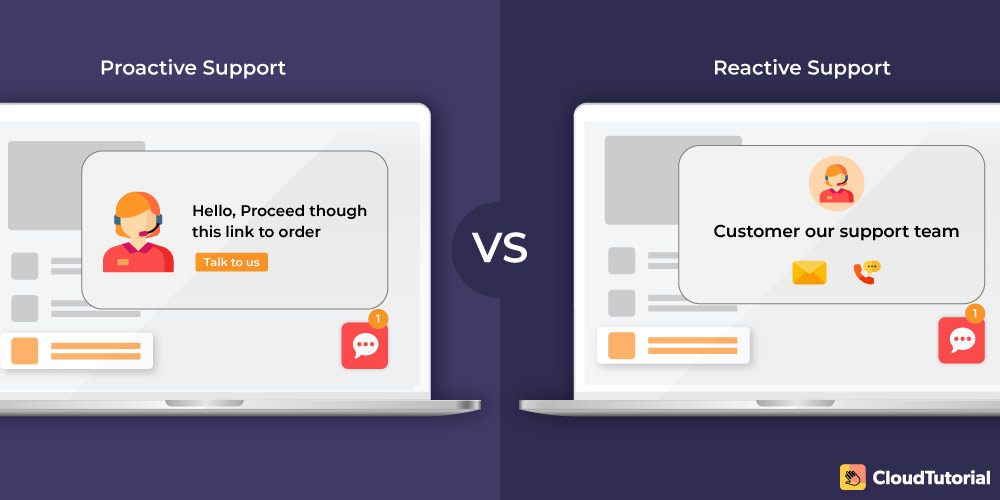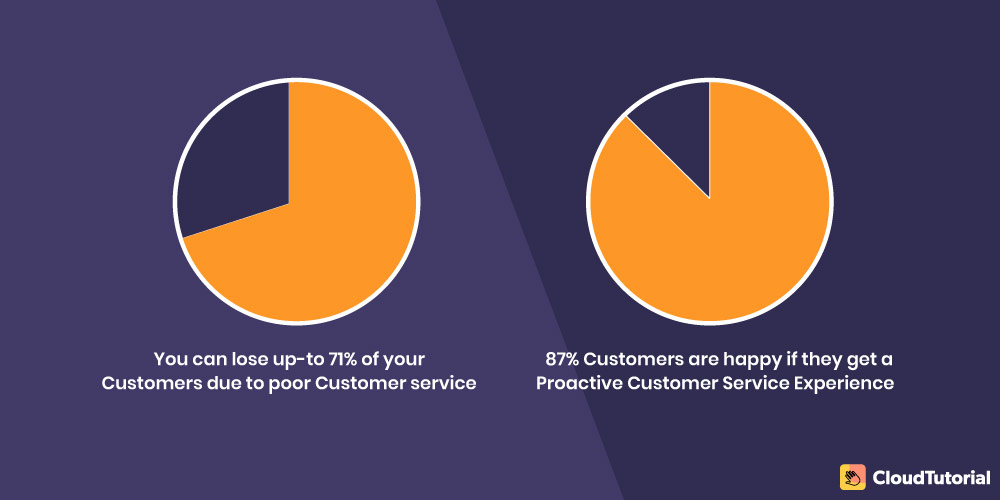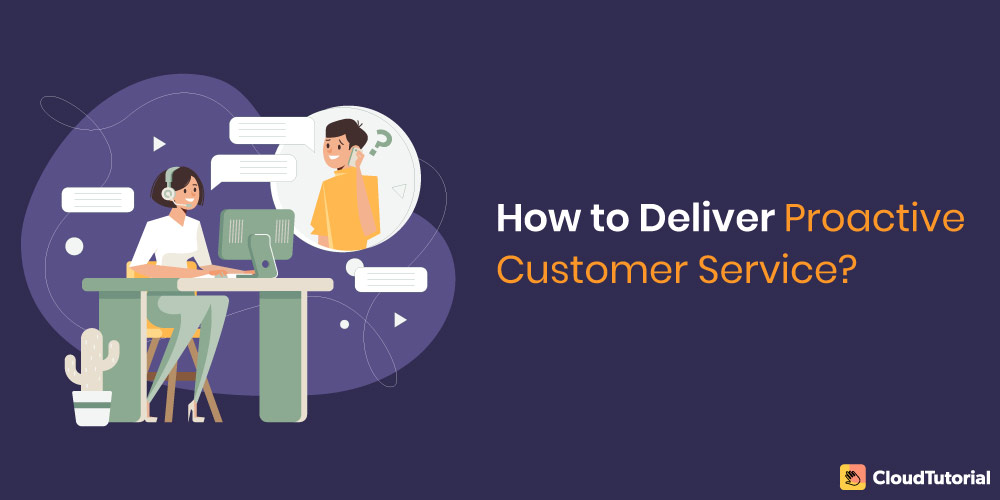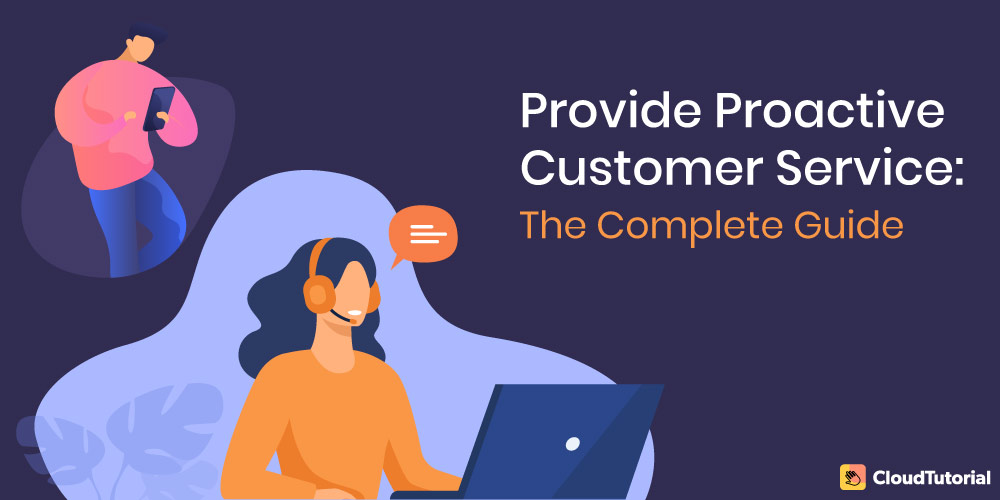Implementing proactive customer service is the best you can do for your business in 2021. I’ll tell you why.
But first things first, I was shocked to know that as per a Smart Customer Service report, U.S brands lose as much as $41 billion every year due to poor customer service. That explains how important customer service is and the kind of influence customer experience can have on your business’s success.
If you pay a little attention to the stats, it says that brands lose money due to poor customer service and not due to lack of it. You see the problem here?
Brands are losing money not because they do not provide customer service, they are losing money because the kind of customer service they are offering is not right – it’s rather poor.
Most businesses you see (and you may be one of them) react to their customer’s problems instead of being proactive about them. That’s the reason I said implementing proactive service is the best you can do for your business. Makes sense?
Now let’s dive right in and understand everything about proactive customer service.
Table of Content
What is Proactive Customer Service?
By definition, Proactive Customer Service is when you reach out to your customers and offer a solution before your customers ask for it.
This can mean introducing new products and services to them, notifying them about delays, mistakes, or glitches, addressing their concerns, or simply answering their questions before they ask.
The point is to take care of your customers’ needs before they ask for them. It’s a no-brainer that this kind of attitude will build you a legacy of customers who trust you and are loyal to your brand.
Proactive vs Reactive Customer Service

If you reach out to your customers before they face a problem or have a question, it’s proactive customer service. Whereas if you wait for your customers to contact you when they have questions or face common issues, it’s reactive customer service.
The other day I ordered something from Amazon. As soon as I placed the order, I got an email – Your order has been confirmed with the delivery date of the order. The email mentioned that the delivery will take a little longer than usual due to COVID.
2 days later, I received an email – Your order has been dispatched and is on the way. The email also mentioned what I need to do if I want to return the order.
You see, I didn’t ask Amazon where my order is, when I’ll receive it, or how to return it. They gave me the details I needed before I asked for it. And I love Amazon for that. I appreciate them for delivering proactive customer service. Amazon earned another engaged, loyal customer right there.
Had Amazon mentioned a customer care email address and contact number on their website and expected me to call them and ask about the delivery details or return policy, that would be reactive customer service.
I can only imagine the hassle and I am thankful they do not adopt a reactive customer service approach. Aren’t you?
Build an advanced knowledge base for your customers and give them answers fast – real fast.
Take your app and help center to the next level with CloudTutorial.
Why should your Business care about Delivering Proactive Customer Service?

- You can lose 71% of your customers due to poor customer service. (kissmetrics)
- 47% of customers would go to your competitor in a day of receiving poor customer service. (24/7)
- 87% respondents in a survey stated that they’ll be happy if they are contacted proactively by a company regarding customer service. (inContact)
- Proactive support leads to higher customer retention. A mere 5% increase in customer retention can lead to a 25-95% increase in your business’s profits. (Bain and company)
I still remember when I had to contact a company for customer support. It was a pretty simple query but I could find neither a resource nor a FAQ section on their website, so I Googled their phone number and called them. I couldn’t reach them at once and had to dial 3 times.
When I finally reached them, all I heard was Your call is important to us. Please stay on the line or call again later. It was torturous. Is it hard to guess that I never called them again later? On a scale from 1 to 10, 1 being the lowest, my customer satisfaction rating was -100.
They lost a customer just like that.
That is what not being proactive can do to your business! And I don’t want this to happen to you.
There are huge benefits of proactive customer service. Proactive support can cause a massive shift in your business. Here’s how-
-
Customer Retention Rates will skyrocket –
As soon as you adopt a proactive approach to customer service, you’ll see an instant 3-5% jump in your customer retention rates. How? Customers stick with a brand that cares about them. And there’s no better way than to deliver solutions before your customers ask to prove that you care.
Being Proactive will also help you reach out to your prospects and widen your customer base.
-
Brand Image will Improve –
Proactive service will build your brand a list of loyal supporters (customers). And happy customers do not only repeat buyers but also refer your brand to other people. All you need to do is make the effort to address customers’ concerns before they ask.
-
Save time and efforts on the part of your support team and customers –
Being proactive will save time and effort as your customer service team member doesn’t have to answer as many customer calls/emails. Why? Because you are providing all the resources beforehand where customers can go and educate themselves.
Proactiveness also saves your customers’ time and efforts as instead of finding your contact information and waiting to connect with the right expert to get their query resolved, all they’ve to do now is look up your resources section.
-
Customers will become Ambassadors –
If you implement proactive customer service, you can not only acquire/ retain more customers and build a following of loyal customers but also turn them into your brand ambassadors.
It is a known fact that happy customers do not hold back from talking enthusiastically about a brand. When your happy customers talk about their great experiences socially, they’ll bring you even more admirers (read: customers).
-
Prevent problem escalation –
Many times tiny – can easily go unnoticeable – problems are warning signs. They can become huge pain points before you know. You can prevent that by making your customer service proactive.
Being customer-centric is a great way to curb the problem before it arises or when it is in its infancy so that it doesn’t escalate and bring negativity to your brand.
-
Improvement Loop –
Proactive service traps you in a loop of improvement which is by far the best way to be trapped. You keep on taking valuable customer feedback and turning it into resources to solve customer issues/educate your customers.
This will tell your customers you listen and care about them. You can also improve your products or services, marketing, operations, and make better decisions as per this feedback.
10 Ways to Deliver Proactive Customer Service

-
Go Heavy on Feedback –
Don’t wait to solve problems as and when they naturally come to light. Make sure you dig out the issues and solve them beforehand. How? By gathering feedback.
Include a feedback form and live chat support tool on your website, send surveys, interview your customers, regularly check messages/comments on Facebook, Instagram, Twitter, and Linkedin, and review what customers say on live chats. All these are great and quick ways to gather tons of feedback.
-
Make social media your best ally –
New York University found out that more than 37% of all tweets (500 million per day) are related to customer service. Chances that your customers will not shy away from expressing their love or hatred for your brand are extremely high.
To take proactive action, make sure you study your social media channels and figure out what your customer needs are, what they are saying about your brand and your competitors, what they are looking for, what are the interesting events you can be a part of, and what are the customer service trends.
-
FAQ section is a must
The FAQ section is the simplest and shortest way to get started. It helps you address customer needs, nurture customer relationships, gain customer loyalty, and deliver proactive customer support.
Analyze all the customer support data you have and I am sure you’ll find tons of repetitive questions and concerns. Why do you want to answer the same questions again and again? What you must do instead is to gather these questions and put them on a FAQ page on your website.
This will not only save you from endless repetitive customer queries but will also give your customers a fixed destination to go to in case of concerns.
Unlike other ways that may take a little time, creating a FAQ page is super quick and easy. There’s this amazing tool called CloudTutorial that will help you build a perfect FAQ page in a matter of a few clicks. I’ll be honest, if there’s one thing you implement from this article today, let it be including a FAQ section on your website.
-
Create content around the information you gather –
When you start to gather feedback and listen intently to what your customers want, you’ll have truckloads of information. Use this information to create content for your customers’ needs.
The best way to help customers is to listen to them and understand their pain points. Create blogs, videos, or podcasts and address their concerns in detail.
Don’t forget to link the content you create to the corresponding FAQ questions. You can create a FAQ section using CloudTutorial. This tool will help you build an organized FAQ section by putting the questions into categories and subcategories.
-
Admit your mistakes when you find out not when your customers find out –
See, mistakes are inevitable. They become embarrassing only if your customers react to them before you do.
The other day my Wi-Fi broke down. As soon as I unlocked my phone to call customer support, I saw a message saying We regret the inconvenience caused. Your connection will be restored within 4 hours. Do you see how a simple action can turn an unhappy customer into a happy one?
As per your product or service, you can issue an apology, offer a discount or a refund, or simply assure them that you’re looking into the issue.
-
Email your way to proactive support –
While social media is great for connecting with your customers, do not ever underestimate the power of personalized emails and email newsletters, especially if you’re a small business.
From stories, updates, discounts, announcements, glitches, to new products or services, or simply a FAQ section/new blog/social media post link, there’s nothing an email cannot contain.
-
Create a Knowledge base –
While you proactively address your customers’ needs, do not forget your customer service team. It is by empowering them that you can achieve great proactive customer support. But how do you empower them?
Well, for starters, you can create password-protected knowledge bases and give them access to it. This knowledge base will contain rules, information, standards, policies, and all that your customer support team will need to serve your customers in the highest possible manner.
I know it sounds overwhelming but believes me, it is not. You can use CloudTutorial to create a comprehensive knowledge base. Yes, the same tool CloudTutorial I recommended you to create FAQ pages. Quite an all-rounder, you see! It is super simple to use, and helps you edit your documents on the go, so no excuses, ok?
-
Leverage Live Chat –
Even if you include 2465945 questions on your FAQ page, there’s always something you’ll miss out on. These are concerns or questions you discover along with your customers. The best way to this discovery is to include a live chat option on your FAQ page.
Customers and visitors can simply chat with you in case they have specific concerns or are looking for detailed answers. Or even better, you can monitor how a customer is interacting with your website and drop a message on the live chat saying Hey, how can I help you today?
-
Self-service is the key here –
The more you allow your customers to self-service themselves, the better. How? Because that just means you’re adopting a proactive customer support approach. Let me explain. See, the moment your customers face an issue, have a question, or run into a problem, the first thing they do is Google it.
Now, if you’re smart (and proactive), and have a dedicated FAQ section on your website wherein the FAQ questions are linked with their respective blogs/content pieces, your website will pop up as your customer’s search result.
How amazing is that? Once your website (FAQ page) becomes a search result when your customers search about a problem related to your products/services, you win!
-
Trust the Data and Analytics –
Put all the data you get to good use to deliver great proactive support. Use the questions, feedback, and concerns you receive to improve your product or service. If a lot of customers are looking for a specific detail in your product, modify your product to add the detail.
Similarly, if something is bothering them, exclude it. All in all, keep on tweaking your product, service, and methods as per the data and analytics you receive.
Build an advanced knowledge base for your customers and give them answers fast – real fast.
Take your app and help center to the next level with CloudTutorial.
Final Thoughts
The proactive approach helps you skyrocket your sales numbers by shooting up your customer acquisition, customer engagement, and customer retention rates, boosting brand reputation, and building a legacy of loyal customers.
Bringing a proactive culture to your company will take time. Remember that you do not have to implement everything at once. All wins happen when you start taking one step in the right direction.
And if I were to suggest what that first step must be, it will be hands down creating a FAQ page and Live Chat for your website. It’s the surest, shortest, and simplest way of implementing proactive customer support provided you use the right tools. It’s like giving your website visitors/customers a destination where they know all their queries, questions, and concerns will be taken care of.
As for the tools, you can always trust CloudTutorial. It is customizable, quick, and data-driven built to give you and your website user exceptional customer service. You can catch up on the features here.
So you see, prevention is always better than cure. Now, when you view that from a customer support point of view, it becomes proactive customer service.
All this information around proactive customer service is now yours. This is the potential power of your business. It will only become your business’s power only when you take action and implement the enlisted tasks. Putting your customers first and winning customer loyalty is attractive, go get started!
Try it out before you decide.
Create a test article NOW!
Using this tool, all you have to do is add your first test article and see how it looks. Now, you don’t have to sign-up or login into CloudTutorial software just to check how your first article appears.

